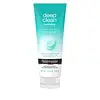What's inside
What's inside
 Key Ingredients
Key Ingredients

No key ingredients
 Benefits
Benefits

 Concerns
Concerns

 Ingredients Side-by-side
Ingredients Side-by-side

Water
Skin ConditioningGlycerin
HumectantMyristic Acid
CleansingStearic Acid
CleansingPotassium Hydroxide
BufferingLauric Acid
CleansingPalmitic Acid
EmollientPEG-32
HumectantCocamidopropyl Betaine
CleansingSodium Cocoyl Glycinate
CleansingPEG-100 Stearate
Glyceryl Stearate
EmollientPhenoxyethanol
PreservativePEG-75
HumectantSodium Chloride
MaskingParfum
MaskingPEG-150 Distearate
EmulsifyingPolyquaternium-7
Ethylhexylglycerin
Skin ConditioningDisodium EDTA
Capric Acid
CleansingHydrolyzed Hyaluronic Acid
HumectantMoringa Oleifera Seed Extract
Skin ConditioningWater, Glycerin, Myristic Acid, Stearic Acid, Potassium Hydroxide, Lauric Acid, Palmitic Acid, PEG-32, Cocamidopropyl Betaine, Sodium Cocoyl Glycinate, PEG-100 Stearate, Glyceryl Stearate, Phenoxyethanol, PEG-75, Sodium Chloride, Parfum, PEG-150 Distearate, Polyquaternium-7, Ethylhexylglycerin, Disodium EDTA, Capric Acid, Hydrolyzed Hyaluronic Acid, Moringa Oleifera Seed Extract
Water
Skin ConditioningGlycerin
HumectantMaltitol
HumectantPropylene Glycol
HumectantPEG-150
HumectantSodium Cocoyl Glutamate
CleansingSodium Lauroyl Aspartate
CleansingLauryl Hydroxysultaine
CleansingPolysorbate 60
EmulsifyingEthylhexylglycerin
Skin ConditioningDisodium EDTA
Dipotassium Glycyrrhizate
HumectantPotassium Hydroxide
BufferingPhenoxyethanol
PreservativeMethylparaben
Preservative
 Reviews
Reviews

Ingredients Explained
These ingredients are found in both products.
Ingredients higher up in an ingredient list are typically present in a larger amount.
Disodium EDTA plays a role in making products more stable by aiding other preservatives.
It is a chelating agent, meaning it neutralizes metal ions that may be found in a product.
Disodium EDTA is a salt of edetic acid and is found to be safe in cosmetic ingredients.
Learn more about Disodium EDTAEthylhexylglycerin (we can't pronounce this either) is commonly used as a preservative and skin softener. It is derived from glyceryl.
You might see Ethylhexylglycerin often paired with other preservatives such as phenoxyethanol. Ethylhexylglycerin has been found to increase the effectiveness of these other preservatives.
Glycerin is already naturally found in your skin. It helps moisturize and protect your skin.
A study from 2016 found glycerin to be more effective as a humectant than AHAs and hyaluronic acid.
As a humectant, it helps the skin stay hydrated by pulling moisture to your skin. The low molecular weight of glycerin allows it to pull moisture into the deeper layers of your skin.
Hydrated skin improves your skin barrier; Your skin barrier helps protect against irritants and bacteria.
Glycerin has also been found to have antimicrobial and antiviral properties. Due to these properties, glycerin is often used in wound and burn treatments.
In cosmetics, glycerin is usually derived from plants such as soybean or palm. However, it can also be sourced from animals, such as tallow or animal fat.
This ingredient is organic, colorless, odorless, and non-toxic.
Glycerin is the name for this ingredient in American English. British English uses Glycerol/Glycerine.
Learn more about GlycerinPhenoxyethanol is a preservative that has germicide, antimicrobial, and aromatic properties. Studies show that phenoxyethanol can prevent microbial growth. By itself, it has a scent that is similar to that of a rose.
It's often used in formulations along with Caprylyl Glycol to preserve the shelf life of products.
Potassium hydroxide is commonly known as caustic potash. It is used to fix the pH of a product or as a cleaning agent in soap. In cleansers, it is used for the saponification of oils.
Sapnification is the process of creating fatty acid metal salts from triglycerides and a strong base. During this process, Potassium Hydroxide is used up and is not present in the final product.
Using high concentrations of Potassium Hydroxide have shown to irritate the skin.
Learn more about Potassium HydroxideWater. It's the most common cosmetic ingredient of all. You'll usually see it at the top of ingredient lists, meaning that it makes up the largest part of the product.
So why is it so popular? Water most often acts as a solvent - this means that it helps dissolve other ingredients into the formulation.
You'll also recognize water as that liquid we all need to stay alive. If you see this, drink a glass of water. Stay hydrated!
Learn more about Water